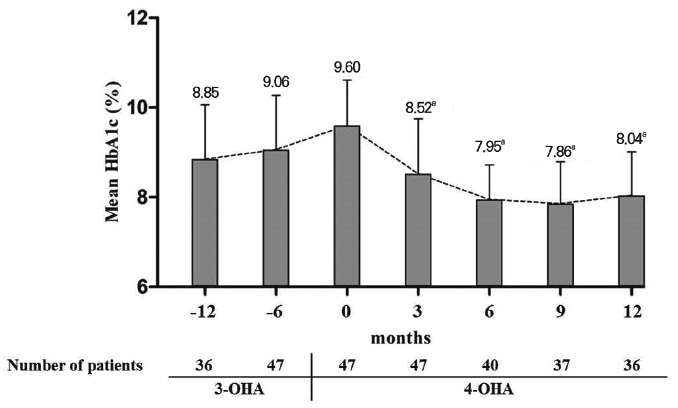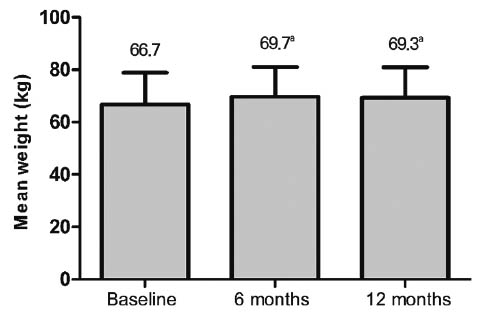J Korean Diabetes.
2019 Jun;20(2):117-126. 10.4093/jkd.2019.20.2.117.
Therapeutic Effect of Quadruple Oral Hypoglycemic Agents in Patients with Type 2 Diabetes Mellitus Who Have Insulin Limitations
- Affiliations
-
- 1Department of Internal Medicine, Dankook University College of Medicine, Cheonan, Korea. chkendo@dankook.ac.kr
- 2Department of Kinesiologic Medical Science, Graduate School, Dankook University, Cheonan, Korea.
- KMID: 2451842
- DOI: http://doi.org/10.4093/jkd.2019.20.2.117
Abstract
- BACKGROUND
Insulin therapy is the treatment of choice in type 2 diabetes mellitus (T2DM) patients who are not achieving glycemic goals despite triple oral hypoglycemic agent (OHA) combination therapy. However, there is still no additional treatment option for patients who cannot afford insulin therapy or who have various clinical limitations. The purpose of this study was to evaluate the clinical efficacy and safety of four OHA combination therapy in poorly controlled T2DM patients who could not afford insulin therapy.
METHODS
Forty-seven T2DM patients were enrolled according to the following criteria: 1) glycosylated hemoglobin [HbA1c] > 8.5%, 2) ongoing treatment with 3 OHA combination therapy (metformin, sulfonylurea, dipeptidyl peptidase-4 inhibitor), or 3) combined limitations for applying insulin therapy. Patients were given the fourth OHA (pioglitazone) in addition to their previous treatment for 12 months. We evaluated changes in HbA1c, body weight, hypoglycemic events, and side effects.
RESULTS
At study completion, mean HbA1c and fasting plasma glucose were significantly reduced from 9.6% to 8.04% and from 198.4 mg/dL to 161.5 mg/dL, respectively (P < 0.001). Mean body weight was significantly increased from 66.7 kg to 69.3 kg. Hypoglycemia and side effects were observed 18 times and only 3 cases showed abnormal liver function tests or edema. In addition, subjects with higher initial HbA1c levels and HOMA-beta showed an independent association with a greater reduction in HbA1c.
CONCLUSION
The 4 OHA combination therapy is effective and safe when insulin is not feasible.
MeSH Terms
Figure
Reference
-
1. American Diabetes Association. 7. Obesity management for the treatment of type 2 diabetes: standards of medical care in diabetes—2018. Diabetes Care. 2018; 41:Suppl 1. S65–S72.2. Korean Diabetes Association. 2015 Treatment guidelines for diabetes (5th edition). updated 2016 Mar 23. Available from: http://www.diabetes.or.kr/pro/publish/guide.php?code=guide&number=638&mode=view.3. Kim SS, Kim IJ, Kim YK, Yoon KH, Son HY, Park SW, Sung YA, Baek HS. Insulin initiation in insulin-naïve Korean type 2 diabetic patients inadequately controlled on oral antidiabetic drugs in real-world practice: The Modality of Insulin Treatment Evaluation Study. Diabetes Metab J. 2015; 39:481–488.
Article4. University of Oxford. HOMA2 calculator. updated 2016 Mar 31. Available from:https://www.dtu.ox.ac.uk/homacalculator/.5. Igarashi M, Jimbu Y, Kimura M, Hirata A, Yamaguchi H, Tominaga M. Effect of pioglitazone on atherogenic outcomes in type 2 diabetic patients: a comparison of responders and non-responders. Diabetes Res Clin Pract. 2007; 77:389–398.
Article6. Davies MJ, Gagliardino JJ, Gray LJ, Khunti K, Mohan V, Hughes R. Real-world factors affecting adherence to insulin therapy in patients with Type 1 or Type 2 diabetes mellitus: a systematic review. Diabet Med. 2013; 30:512–524.
Article7. Zinman B. Initial combination therapy for type 2 diabetes mellitus: is it ready for prime time? Am J Med. 2011; 124:1 Suppl. S19–S34.
Article8. Turner RC, Cull CA, Frighi V, Holman RR. UK Prospective Diabetes Study (UKPDS) Group. Glycemic control with diet, sulfonylurea, metformin, or insulin in patients with type 2 diabetes mellitus: progressive requirement for multiple therapies (UKPDS 49). JAMA. 1999; 281:2005–2012.
Article9. Satoh N, Ogawa Y, Usui T, Tagami T, Kono S, Uesugi H, Sugiyama H, Sugawara A, Yamada K, Shimatsu A, Kuzuya H, Nakao K. Antiatherogenic effect of pioglitazone in type 2 diabetic patients irrespective of the responsiveness to its antidiabetic effect. Diabetes Care. 2003; 26:2493–2499.
Article10. Moon JH, Kim HJ, Kim SK, Shim WS, Kang ES, Rhee Y, Ahn CW, Lim SK, Kim KR, Lee HC, Cha BS. Long-term effect of pioglitazone treatment in patients with type 2 diabetes. J Korean Diabetes Assoc. 2006; 30:264–276.
Article11. Seufert J, Urquhart R. 2-year effects of pioglitazone addon to sulfonylurea or metformin on oral glucose tolerance in patients with type 2 diabetes. Diabetes Res Clin Pract. 2008; 79:453–460.
Article12. Triplitt C, Glass L, Miyazaki Y, Wajcberg E, Gastaldelli A, De Filippis E, Cersosimo E, DeFronzo RA. Comparison of glargine insulin versus rosiglitazone addition in poorly controlled type 2 diabetic patients on metformin plus sulfonylurea. Diabetes Care. 2006; 29:2371–2377.
Article13. Rosenstock J, Einhorn D, Hershon K, Glazer NB, Yu S;. Efficacy and safety of pioglitazone in type 2 diabetes: a randomised, placebocontrolled study in patients receiving stable insulin therapy. Int J Clin Pract. 2002; 56:251–257.14. Charbonnel B, Schernthaner G, Brunetti P, Matthews DR, Urquhart R, Tan MH, Hanefeld M. Long-term efficacy and tolerability of add-on pioglitazone therapy to failing monotherapy compared with addition of gliclazide or metformin in patients with type 2 diabetes. Diabetologia. 2005; 48:1093–1104.
Article15. Campbell IW. Long-term glycaemic control with pioglitazone in patients with type 2 diabetes. Int J Clin Pract. 2004; 58:192–200.
Article16. Blüher M, Lübben G, Paschke R. Analysis of the relationship between the Pro12Ala variant in the PPARgamma2 gene and the response rate to therapy with pioglitazone in patients with type 2 diabetes. Diabetes Care. 2003; 26:825–831.
- Full Text Links
- Actions
-
Cited
- CITED
-
- Close
- Share
- Similar articles
-
- Clinical Practice Guideline 2015: Oral Hypoglycemic Agents for Patients with Type 2 Diabetes
- DPP-4 Inhibitors as a New Option for the Management of Type 2 Diabetes
- A Pregnant Woman with Type 2 Diabetes Unintentionally Exposed to Metformin and Voglibose until the Second Trimester of Pregnancy: A Case Report
- A Case of Insulinoma Associated with Type 2 Diabetes Mellitus
- Use of Oral Hypoglycemic Agents in Type 2 Diabetic Patients with Hepatic Dysfunction




